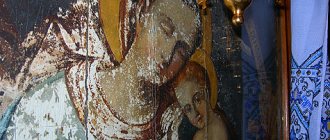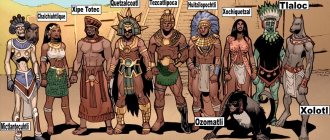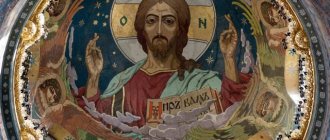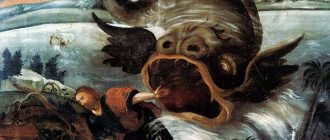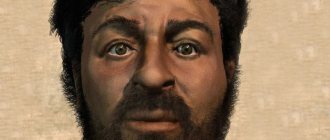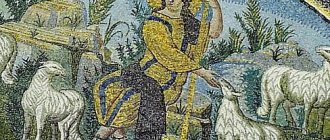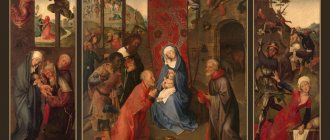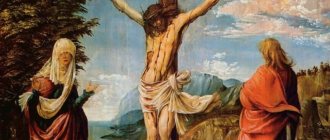Jesus Christ, the central figure of Christianity, has been depicted in paintings many times throughout Western art. The Renaissance was a movement in Europe from the 14th to 17th centuries that saw renewed interest in ancient Greco-Roman culture. Religious paintings were very common during the Renaissance and several paintings from this era appear on our list. Many incidents from the life of Jesus have been depicted by numerous artists from different artistic eras. Da Vinci's Last Supper depicts the moment when Jesus tells his disciples that one of them will betray him; Caravaggio's Supper at Emmaus depicts the moment when the resurrected Jesus first appeared to two of his disciples. Christ on the cross has also been a favorite theme of artists and appears in three of the paintings on our list: Christ Crucified by Diego Velazquez; "Yellow Christ" by Paul Gauguin; and "Christ of St. John of the Cross" by Salvador Dali. Here are 10 of the most famous paintings of Jesus Christ.
Crucified Christ
Artist: Diego Velazquez
Year: 1632
Crucified Christ, Diego Velazquez
Diego Velázquez was a Spanish artist active in the 17th century who is considered a leading figure of the Spanish Golden Age. He is highly regarded for his portraiture. Velazquez was the official artist of King Philip IV. This painting, painted by Velazquez in the middle of his life, shows Jesus on the cross immediately after his death. The remarkable thing about the painting is that it lacks any narrative elements other than the cross. A work of incredible originality. A masterful combination of serenity, dignity and nobility, the painting "The Crucified Christ" made it a turning point in Velazquez's artistic development. This is the artist's most famous painting on religious themes, which served as a source of inspiration for the creation of many works of literature, in particular Miguel de Unamuno's poem "El Cristo de Velazquez".
Yellow Christ
Artist: Paul Gauguin
Year: 1889
The Yellow Christ (1889) - Paul Gauguin
Active primarily during the 19th century, Paul Gauguin was a French artist who is now considered one of the most important artists of the Post-Impressionism art movement, which extended Impressionism by rejecting restrictions. Along with another painting by Gauguin entitled "The Green Christ", this painting is one of the first and most important works of symbolism in painting. Yellow Christ shows the crucifixion of Christ, which takes place in the nineteenth century in northern France, with women gathered in prayer. The composition features a variety of symbolism, like the man running in the background, reflecting the 19th century desire to escape the hustle and bustle of the city and return to the "primitive" and much simpler life that existed before. Symbolism aside, the Yellow Christ is the culmination of Gauguin's "synthetic" style. It was created using planes, bright colors and bold outlines.
"The Crucifixion" by Fra Angelico
"Crucifixion" ca. 1420, Fra Angelico
Fra Angelico's small panel of 1420 at first glance includes many elements and figures, but places them in a more methodically constructed space. This transformation in painting reflects a whole shift and also imbues the scene with a heightened reality. In addition, Fra Angelico enhances the emotional responses of the figures around the single cross of Christ. Here the Virgin Mary falls to the ground, Saint John clasps his hands tightly, and the angels mourn the golden earth and heaven. The semicircle of spectators reflects postures of indifference, pity or surprise.
Dinner at Emmaus
Artist: Caravaggio
Year of issue: 1601
Supper at Emmaus (1601) - Caravaggio
Caravaggio was an Italian artist whose paintings combine realistic observation of the human condition, both physical and emotional, with dramatic use of lighting. He is considered one of the most influential artists in Western art and his work had a defining influence on the Baroque school of painting. One of the most famous religious paintings created by Caravaggio, The Supper at Emmaus depicts the moment when the risen Jesus Christ first appeared to two of his disciples; most likely Luke and Cleopas; in the city of Emmaus. The painting actually captures the exact moment when the two apostles realize that they have witnessed an unimaginable miracle. Christ is shown without a beard, and his flowing robes hide all signs of wounds received during the crucifixion.
"The Crucifixion" by Pietro Lorenzetti
Pietro Lorenzetti "Crucifixion" fresco. 1320 Church of San Francesco, Assisi
The culmination of the Passion story is the Crucifixion itself. Paintings on this theme were intended to stimulate reflection on Christ's self-sacrifice. The plot demonstrates the full power of suffering. The figure of Christ is rarely distorted, and his naked body is often idealized and based more on classical concepts. The cross can be surrounded by many other figures, which are often distinguished by their expressiveness. On a small altar by Pietro Lorenzetti, Christ is crucified between two other figures. The Virgin Mary in the foreground loses consciousness, and many figures (some in Oriental clothing, others in Roman armor) gaze intently and emotionlessly at Christ.
Savior of the world
Artist: Leonardo da Vinci
Year: 1519
Salvator Mundi (1500) - Leonardo da Vinci
Leonardo da Vinci was an Italian artist who is now considered a multi-talented genius. But for four centuries after his death, his fame rested primarily on his laurels as an artist, and even today he is considered one of the greatest artists in the history of Western art. The first recorded owner of this painting was King Charles I of England. The painting was auctioned by the son of the Duke of Buckingham in 1763 and acquired in 1900 by the British art collector Sir Francis Cook, whose descendants sold it at auction for just £45. It was only in the first decade of the 21st century that the work was restored and recognized as the work of da Vinci, thereby bringing itself into the spotlight. The painting depicts Jesus Christ as Salvator Mundi (Savior of the world). In the painting, he is in Renaissance clothing giving a blessing with his raised right hand; and his left hand holds a crystal ball.
Transfiguration
Artist: Raphael
Year: 1520
Transfiguration (1520) - Raphael
Raphael was one of the three great masters of High Renaissance art, along with Michelangelo and Leonardo da Vinci. The Transfiguration is the last painting he created. It is divided into two separate parts. The upper half of the painting depicts the transfiguration of Christ with the prophets Elijah and Moses on either side of him. At the bottom, the apostles try unsuccessfully to rid a possessed boy of demons. The painting can be interpreted as depicting the contrast between god and man; Moreover, the upper part is clean and symmetrical, and the lower part is dark and chaotic. To Napoleon, Raphael was simply the greatest of Italian artists, and the Transfiguration his greatest work, and art historian Giorgio Vasari calls Raphael's painting his "most beautiful and most divine" work.
Christ of Saint John of the Cross
Artist: Salvador Dali
Year: 1951
Christ of Saint John of the Cross (1951) - Salvador Dali
Salvador Dali is considered the most influential artist of the surrealist movement. This painting is known as the Christ of Saint John of the Cross because its design is based on a drawing by the 16th century Spanish friar John of the Cross. The composition consists of a triangle, which is formed by the hands of Christ and the horizontal of the cross and a circle formed by the head of Christ. The triangle can be seen as a reference to the Holy Trinity, while the circle can represent unity, that is, all things exist in three. Although the painting depicts a crucifixion, there are no nails or blood. According to Dalí, the inspiration for the painting came to him through a cosmic dream in which he was convinced that depicting nails and blood would spoil his depiction of Christ. Christ of St John of the Cross was voted the most loved painting in Scotland in a 2006 poll. It is one of the most famous works by one of the leading modern artists and is considered by many to be the greatest religious painting of the 20th century.
Phobias and addictions of Salvador Dali in his paintings
In his work, the great surrealist coordinated his strong phobias with his deep passions. Dali was obsessed with eroticism, masturbation and dreams.
He depicted heads, eggs, elephants, crustaceans, and butterflies. The appearance of each element on his canvas can be justified according to Freud.
Salvador Dali's surreal images retain their impact decades later and are always worth a second look.
"The Persistence of Memory", 1931.
Insects
Crawling and swarming black ants, bright butterflies flying singly or in groups, a small grasshopper sitting on a deformed head - the master’s paintings are filled with insects that terrified him. Ants symbolize decay and fear of death. Grasshoppers, which appear with some regularity, have been a fear of Dali since childhood.
The painting “The Persistence of Memory” is on the wall of the museum. Photo ©Christina Whiting.
Tiny things
Salvador Dali was endlessly fascinated by many tiny things. Except for insects, of course. He liked olives, bread crumbs, grains of sand. The artist believed that little things have the power to destroy creatures a hundred times larger than themselves. And many of his early paintings are very miniature.
The famous painting “The Persistence of Memory” is of enormous importance in the history of modern art, but the dimensions of the work are only 24x33 cm.
Lobster here, lobster there, lobster everywhere.
Crustaceans
In Dali's symbolism, the shell represented armor that protects the soft being hidden within it. This concept was closely related to the hermit artist himself, who needed a hard shell that could protect him from the outside world.
Lobsters became a central element not only in his painting. Collaborating with outrageous designer Elsa Schiaparelli, Dali painted a huge red lobster on a white silk dress. And in 1936, he created the surreal sculpture “Lobster Telephone,” which consisted of a rotary telephone and a plaster lobster attached to it, replacing the traditional handset.
"Eggs on the Plate without the Plate", 1932 (Not flat eggs on a flat plate). Hard on the outside, soft and flimsy on the inside.
Eggs
Like crustaceans, eggs have a hard shell that protects the soft contents. Eggs are a fetal form, so they symbolize birth, new life and hope. Dali clearly had a passion for them. Eggs appear whole, for example in the painting “Metamorphoses of Narcissus,” and broken, as in the image above. And the building of the Dali Theater-Museum is topped with giant eggs.
"The Accommodations of Desire", 1929.
Female sexuality
Ironically, despite his love for eggs, Dali was horrified by their origin. Female sexuality and its components horrified him. In the painting “Bleeding Roses,” he literally depicted blood flowing from the female abdominal organs. In "The Adaptability of Desire" (above), lion heads represent toothy sheaths. This powerful image represents the potential of a woman to traumatize or even castrate a man during sexual intercourse, Dali's main phobia.
"The Great Masturbator", 1929.
Masturbation
Salvador Dali had an aversion to sex but was obsessed with masturbation. It is even widely believed that this was almost the only form of his sexual activity. References to this hobby are found in the films “The Great Masturbator” and “Hitler Masturbates.” The surreal work “Dark Game” also features the hand motif in various variations.
"Ballerina in a Death's Head" (1939) and "Skull of Zurbaran" (1956).
Skulls
Staying true to his paradoxical nature, Dali was afraid of death, but did not deviate from this topic. Skulls, as a representation of human mortality, appear regularly in his paintings. In “The Vaporized Skull Sodomizes the Piano on the Coda” (1934), the skull is deformed and disturbed. In the painting “The Face of War” the symbol of death is multiplied by the repeated image of skulls in the holes of the ugly head.
The most colossal images of skulls in Dali's work are those composed with the help of other elements, as in the work "Ballerina in the Head of Death", which inspired many artists.
"Anthropomorphic Locker", 1936.
Boxes
Sigmund Freud's books, especially The Interpretation of Dreams, delighted the artist. They even met shortly before the psychoanalyst's death. Dali responded to Freud's approach to the hidden recesses of the subconscious, the source of dreams and the driving force of the artist's creativity. The paintings "Anthropomorphic Locker" and "Giraffe on Fire" exemplified the use of boxes built into the human figure to show hidden aspects of personality.
Having become a famous artist, Dali turned to religious themes in the late 1940s. Photo © Getty Images.
Religion
As a child, Dali faced controversy. His mother was a deeply religious Catholic, and his father showed an aversion to religion. In his mature years, the artist experienced a renewal of faith and became interested in the traditional iconography of Christianity. He became interested in its metaphysical aspects and the possibility of integrating religion and science. From the late 1940s and 50s, the artist created a series of overtly religious paintings, including The Last Supper, several versions of the crucified Christ, and a Madonna in which the features of his main inspiration, Gala, can be discerned.
Inspired by the atomic bomb, Salvador Dali painted The Exploding Head of Raphael, 1951.
Science/Physics
Dali was passionate about religion and at the same time was passionate about science, in particular quantum and nuclear physics. He read issues of the popular science magazine Scientific American and liked to discuss its contents. This was the atomic age. The creation of nuclear weapons impressed the artist, after which he created the paintings “The Crucifixion or the Hypercubic Body” and “The Exploding Head of Raphael.”
All images: Gala-Salvador Dali Foundation.
November 17, 2015
Sistine Madonna
Artist: Raphael
Year: 1512
Sistine Madonna (1512) - Raphael
Raphael's art is known for sweetness and clarity of form, serenity, harmony, perfection and visual brilliance. Its popularity was primarily due to its numerous paintings of the Madonna and Child Christ. The Sistine Madonna depicts the Madonna with the Christ Child; between Saints Sixtus and Saint Barbara. Additionally, underneath Mary there are two winged cherubs, which are perhaps the most famous cherubs depicted in any painting. Their popularity is so great that there are many legends about how Raphael painted them. They have been reproduced on everything from paper napkins to umbrellas. The Sistine Madonna is considered one of the best paintings by many famous critics, especially popular in Germany, where it was proclaimed “the highest among the paintings of the world” and received the epithet “divine”.
Last Judgment
Artist: Michelangelo Buonarroti
Artist: 1541
The Last Judgment (1541) - Michelangelo
Michelangelo had an unprecedented influence on the development of art in the West. He is widely considered the greatest sculptor of all time and, although he has a low opinion of painting, he is also considered one of the greatest artists. The Last Judgment is one of the most influential fresco works in the history of Western art. Painted on the altar wall of the Sistine Chapel in the Vatican, it depicts the Second Coming of Christ (the future return of Jesus to earth) and God's final and eternal judgment of all mankind. Jesus is depicted in the center of the painting, surrounded by prominent saints; while the Resurrection of the Dead and the Descent of the Damned into Hell are shown in the area below. Although The Last Judgment is one of the most famous religious paintings, it has caused a lot of controversy. Among other things, Michelangelo was accused of mixing figures from pagan mythology with the depiction of a Christian subject and of seeking artistic effect rather than following the biblical account of the event.
DARKNESS AND LIGHT
review by Alexander Men
"Christ St. John on the Cross" is one of the most famous paintings by Salvador Dali. In 1951, the artist switched to the position of Catholic surrealism, and the frightening images born of the darkness of the subconscious were replaced in his work by a new interpretation of Christian symbols. Like much of Dali's art, this painting is associated with the Spanish spiritual tradition.
Dali's Saint John is Juan de la Cruz (1542 - 1591), a famous mystical poet who lived during the Catholic Reform. He was born into an impoverished noble family and as a young man joined the Carmelite monastic order, which attracted him with its harsh rules.
Already a monk, Juan studied at the University of Salamanca. His friendship with Teresa of Avila, abbess of the female branch of Carmel, writer, and champion of the transformation of church life, had a huge influence on his inner life. She fought a difficult battle with the clerical conservatives, and Juan, involved in this struggle, ended up in prison. With Teresa's help, he escaped in 1578. But in conclusion, Juan wrote “Spiritual Songs,” which were included in the golden fund of Spanish poetry. In them, using images from the biblical Song of Songs, Juan de la Cruz showed man's thorny path to comprehending Eternity.
Juan's mysticism is imbued with a thirst for unity with the divine Mystery of Being. Inner experience told him that the soul ascending the steps of contemplation would face difficult trials, a “dark night” that not everyone could overcome. The absolute and the earthly are separated by an abyss. The experience of the “dark night” is similar to death. The conviction that the Absolute itself comes to meet people halfway helps to withstand it. Juan perceives the suffering of Jesus on the cross as the suffering of Heaven descending to earth. On the steep steps of the spiritual path, everything earthly in a person is burned out, while the Cross of Christ is the humiliation of the Divine.
Naturally, Juan's mysticism frightened his contemporaries. He was considered a heretic and possessed because Juan argued that the true way to Christ was the way of the cross. “Oh, souls who dream of calm and consoling spiritual paths, if only you knew how much you need to suffer in order to achieve this consolation and tranquility; if you knew how impossible this is without suffering and how without it you would not seek any consolation either in God or in creation, but would prefer the cross to them.”
The meaning of Dali's painting is connected with the harsh teachings of Juan de la Cruz.
We see a calm lake with a fishing boat on the shore. This is both an allusion to the gospel sermon at the Sea of Galilee, and at the same time a symbol of an enlightened life. The rays of the rising dawn illuminate the peaceful picture, but above it is the glow and black abysses of space. These are the abysses whose silence frightened Pascal. This is the Christ about whom philosophers and poets wrote. The dark abyss is only slightly covered by the golden “day cover”. “That’s why the night is scary for us” (Tyutchev). The unknown, the incomprehensible, surrounds the peaceful lake of life, an island in the endless ocean of darkness.
However, following the concept of Juan, Dali sees in the black abyss the image of Christ, suffering for the sake of unity with the world, for the sake of introducing it to the light. A giant crucifix stretched over the lake, protecting its fragile earthly tenderness, reminding that life is protected by the Cross.
Dali knew the tragedy of life. He understood that Chaos is hidden not only in the abyss, but also in man. He mercilessly opened up the world of the subconscious, showing the Chaos that stirs in its dark corners. In the film “Christ St. John" he contrasts it with the harmony of the spirit, the harmony that is achieved through struggle and suffering, through the cross - the cross of man and the cross of God, which unites them.
The Calling of Saint Matthew
Artist: Caravaggio
Year: 1600
The Calling of Saint Matthew (1600) - Caravaggio
Saint Matthew was one of the twelve apostles of Jesus and, according to Christian tradition, one of the four evangelists. Matthew was originally a tax collector, and Jesus Christ found him sitting at the tax collector's booth. “Follow me,” Jesus told him, and Matthew stood up and followed him. This painting depicts the moment when Jesus inspires Matthew to follow him. Caravaggio is one of the most influential artists in the history of European art. Among other things; he painted from life, without drawings, and developed a technique called tenebrism, which used sharp contrasts of light and dark. This helped him create paintings with high drama and emotional intensity. The Calling of Matthew remains one of the most famous works of the Baroque period.
last supper
Artist: Leonardo d'A Vinci
Year: 1498
The Last Supper (1498) - Leonardo da Vinci
"The Last Supper" is Leonard da Vinci's most famous artistic achievement after the Mona Lisa. This painting represents the scene of the Last Supper of Jesus with his disciples. In it, Leonardo masterfully depicts the confusion that arises among Jesus' disciples when he announces that one of them will betray him. Leonardo's detailed knowledge of anatomy, light, botany and geology; his interest in how people convey emotion in expressions and gestures and his subtle gradation of tone; everything came together to make this painting one of the most revered and famous religious paintings of all time. Some people believe that the person to the right of Jesus in the painting is not the Apostle John, but a woman named Mary Magdalene. This belief plays a central role in Dan Brown's science fiction novel The Da Vinci Code. The Last Supper is in all likelihood the most famous painting featuring Jesus Christ.
"The Betrayal of Christ" by Bartolomeo di Tommaso
Bartolomeo di Tommaso “The Betrayal of Christ” Italy, before 1425
“The Betrayal of Christ” is one of the most dramatic moments in the narrative of the Passion. The version written by Bartolomeo di Tommaso in the predella panel shows the disturbing mixture of gentleness and cruelty of the episode when Judas, the disciple of Jesus, greets him with a kiss and then betrays him to a band of armed men.
